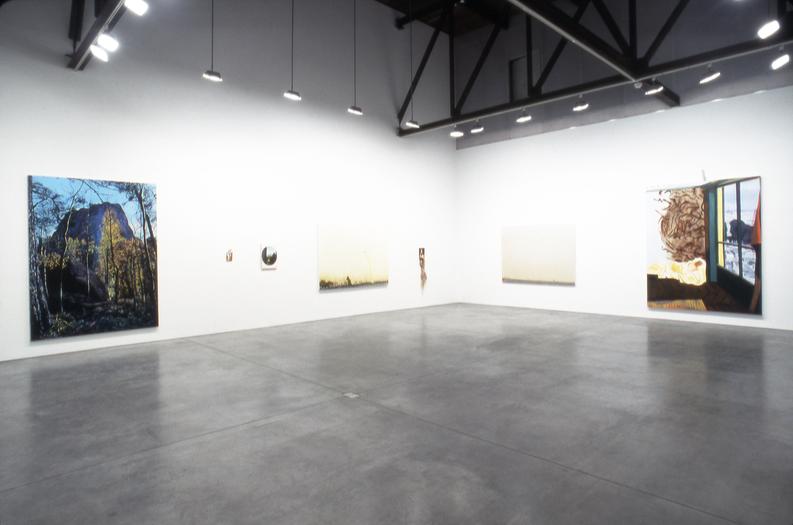Exploring Landscape: Eight Views from Britain
Dan Perfect, Tim Stoner, Michael Ashcroft, Daniel Sinsel, Nigel Cooke, Dexter Dalwood, Dee Ferris, Dan Hays -- curated by Susanna Greeves
January 24 – February 22, 2003
Main Gallery
We are pleased to be showing eight young painters currently working in London, some recent graduates, others already well established, though none have yet been shown in New York. In recent years the British art scene has been characterised above all by diversity, a flourishing of artistic activity and proliferation of spaces which has successfully frustrated attempts to identify a post-yBa movement. What does seem unmistakable is a strong resurgence of interest in painting, and even specifically in realism and narrative. We might tentatively identify some other emerging traits, among them an awareness of art history; a less confrontational stance, even a softness or romanticism; a whimsical or ironic sense of humour; and a labour-intensive care in the making. The thread which draws together this particular group of very different artists is their various explorations in painting landscape, explorations which take them very far from that genre's particular historical associations with Britain, into realms of fantasy and imagination, and to the borders of abstraction.
These artists relate to landscape at a remove, through found images or mediated by technology; or they create virtual, artificial and visionary landscapes, generated entirely in the imagination. Despite this estrangement from nature, they find various ways to channel landscape's rich associations, and even consciously engage with the history of man's long relationship with nature through art. Most striking is the enormous variety and freedom these eight artists have found within a very traditional genre, while stretching its boundaries to the utmost. It seems that the subject can be a means of admitting viewers into the painting, while the genre itself provides a form or pretext for the true focus of the artists' attention, which remains the contemporary challenge of painting.
The origins of Dan Hays' Colorado Impressions are images downloaded from the happened-upon website of an American namesake. This view has played Mont St.Victoire to Hays' Cezanne-like series of paintings, analyses of a landscape under changing conditions - which in his case are artificially imposed by computer manipulation. The fragmentation of the scene into vibrating bands and blocks of colour forms a connection between Post-Impressionism and the pixellation of digital imagery as means of abstracting and organising visual information.
Michael Ashcroft addresses our relationship to grandeur, beauty and the sublime in nature. His subject is not nature as directly experienced, however, but as already mediated by other eyes; that is framed, composed, 'improved', or selected for maximum power to inspire. Earlier paintings were versions of nineteenth century landscapes of the American sublime; these latest are based on an atlas promoting the natural glories of the USSR. In either case the source images are small and of poor quality, reanimated by Ashcroft's imagination.
The post-apocalyptic landscapes of Nigel Cooke are both vast and claustrophobic. On approach their open expanses resolve into oppressive walls, which press against the picture plane narrow strips of foreground overloaded with hallucinatory, hyper-realistic detail: it is a vertiginous plunge from macro to micro. In lavishing this excessive, extravagant labour and attention to detail on his scenes of decay and dissolution, Cooke grapples with the futility and exhaustion of painting itself, and finds a means of recharging it with energy and tension.
Dexter Dalwood makes history paintings of our recent past; scenes of silent anticipation or mute witness to events of living memory, or fabricated landscapes from our popular imagination: Kurt Cobain's greenhouse, Mao Tse Tung's study, Sharon Tate's House, the Queen's bedroom. Collaged into these scenes are quotations from artists who similarly share familiarity and historical distance. In Chappaquiddick, a small splash marks the fateful plunge of Teddy Kennedy's car; the sheer bank is a Morris Louis stain of green. Young Rimbaud, (a rare instance of a figure in a Dalwood painting), sleeps in the Paris apartment of Paul Verlaine. Above him the patterned wall, or swirling ectoplasm of his dreams, is the same sensuous smear that surrounds the IRA dirty protestor in Richard Hamilton's painting 'The Citizen'.
Landscapes in Dan Perfect's paintings are defined by simple bands of vibrant colour, creating receding perspectives of a technicolour realm in which motifs suggestive of flora and fauna interact. These varied, inventive forms and marks are generated in Perfects loose, unconscious drawings and become deftly manipulated formal elements in the paintings. His titles confirm the connection of these playful, sensual environments to the world of animation and computer games.
Landscape can be a potent symbol of escapism and the exotic, evoking an Arcadia or Eden both longed-for and unattainable. The generic exoticism of Tim Stoner's tropical paradise could be straight from a travel poster: he trades in the iconography of consumer desire, acknowledging both the truth of its appeal and its exhaustion through over-use. More than one critic, though, has found something sinister in the cold radiance that haloes his figures. Dee Ferris offers us seductive glimpses of another kind of Eden; one which seems perpetually on the point of dissolving out of our reach, into the liquid light which fills her paintings. Their sprinkling of glitter suggests both romance and artifice. Daniel Sinsel has populated his woods and pastures with lusty boys liberated from porn magazines. The real horns and tail he has attached lend classical, as well as animal overtones, suggesting satyrs at a bacchanal. In another perfect, jewel-like landscape, a flower and insect are less direct allusions to sexuality in nature.
This exhibition has been curated by gallery director Susanna Greeves, who recently relocated from London where she was a director of the Anthony d'Offay Gallery from 1996 to 2002.
